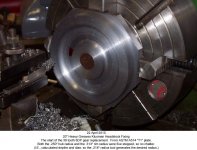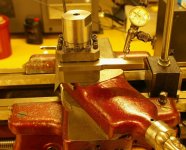Clive603
Titanium
- Joined
- Aug 2, 2008
- Location
- Sussex, England
Agreed to make some 47 mm bore carburettor intake bell mouths in the the same style as the old short aluminium ones fitted to Amal RN and TT carburettors.
Turns out it's gonna be a bit of a nightmare all round but the part I really need help with is how to produce the inside radius between lip and bore. The curve is near enough 130° at 18 mm radius. A form tool will have a cutting length of almost 14 mm which, I think, is pretty much certain to chatter. Especially as the required sequence of operations means the workpiece won't be as well supported as one would ideally like when it comes to finishing the curve. I've not got anything in stock to make a suitable form cutter without ridiculous amounts of grinding.
I do have a nice 10 mm diameter 3/4 circle shaped lathe tool that will get into the bore OK and both my lathes have taper turning attachments. So I figured that a 10 mm Ø cutter will do to make a suitable curved template with appropriate straight lead ins and lead outs. The template can then be set on one of the lathe taper turner guide rails and the groove followed with a freely rotating 10 mm pin supported in the hole provided to bolt the lathe cross slide to the taper turning attachment shoe. Obviously I'll need to make the slot touch over width so the pin can rotate. Using a fixed follower pin in pure sliding contact is, I think, going to be very high friction and near certain to jam.
I've never done anything like this before so the question is which lathe to use and how to go about the job.
The Pratt & Whiney has a dual cross slide arrangement where the taper turning, or in this case template following, movement is completely independent of the feeds. I'd prefer to do the job on this machine but that assumes it can follow the rather tight bend and long, in angle terms, arc. Mounting the template will be harder as it has to sit in the U channel but it's do-able.
The Smart & Brown 1024 normally requires the cross slide feedscrew to be disconnected for taper turning. It has a guide bar rather than U bar so mounting the template will be much easier. Plan with this machine is to leave the cross slide feedscrew connected and manipulate the saddle feed and cross feeds so the pin follows one side of the template. But which side of the template groove is it best to follow and which way to feed. Seems to me that working out from the bore would be best as both cutting forces and following forces are woking in the same direction against the feed.
What do the experts suggest?
If all else fails I suppose I could do a crash course in learning to use the cherrying head that's sat on the back of the Bridgeport. Or even get round to learning CNC to put it on the unused "white elephant" Taig toy CNC mill sat in the "disgrace corner" of the shop that I wasted far too much "it seemed a good idea at the time" money on around 15 years ago.
Clive
Turns out it's gonna be a bit of a nightmare all round but the part I really need help with is how to produce the inside radius between lip and bore. The curve is near enough 130° at 18 mm radius. A form tool will have a cutting length of almost 14 mm which, I think, is pretty much certain to chatter. Especially as the required sequence of operations means the workpiece won't be as well supported as one would ideally like when it comes to finishing the curve. I've not got anything in stock to make a suitable form cutter without ridiculous amounts of grinding.
I do have a nice 10 mm diameter 3/4 circle shaped lathe tool that will get into the bore OK and both my lathes have taper turning attachments. So I figured that a 10 mm Ø cutter will do to make a suitable curved template with appropriate straight lead ins and lead outs. The template can then be set on one of the lathe taper turner guide rails and the groove followed with a freely rotating 10 mm pin supported in the hole provided to bolt the lathe cross slide to the taper turning attachment shoe. Obviously I'll need to make the slot touch over width so the pin can rotate. Using a fixed follower pin in pure sliding contact is, I think, going to be very high friction and near certain to jam.
I've never done anything like this before so the question is which lathe to use and how to go about the job.
The Pratt & Whiney has a dual cross slide arrangement where the taper turning, or in this case template following, movement is completely independent of the feeds. I'd prefer to do the job on this machine but that assumes it can follow the rather tight bend and long, in angle terms, arc. Mounting the template will be harder as it has to sit in the U channel but it's do-able.
The Smart & Brown 1024 normally requires the cross slide feedscrew to be disconnected for taper turning. It has a guide bar rather than U bar so mounting the template will be much easier. Plan with this machine is to leave the cross slide feedscrew connected and manipulate the saddle feed and cross feeds so the pin follows one side of the template. But which side of the template groove is it best to follow and which way to feed. Seems to me that working out from the bore would be best as both cutting forces and following forces are woking in the same direction against the feed.
What do the experts suggest?
If all else fails I suppose I could do a crash course in learning to use the cherrying head that's sat on the back of the Bridgeport. Or even get round to learning CNC to put it on the unused "white elephant" Taig toy CNC mill sat in the "disgrace corner" of the shop that I wasted far too much "it seemed a good idea at the time" money on around 15 years ago.
Clive





